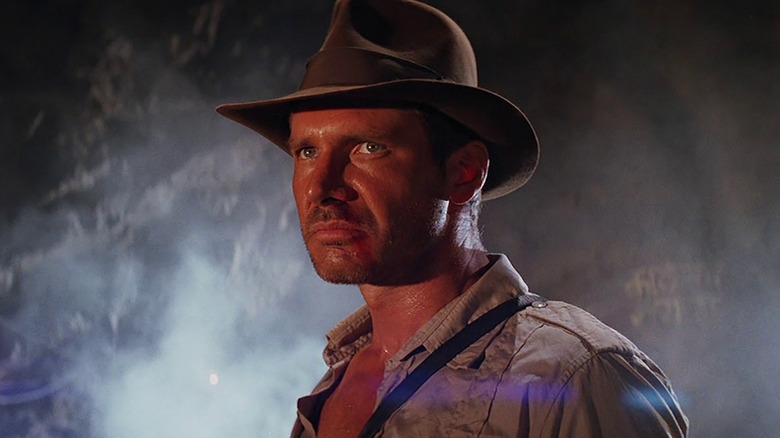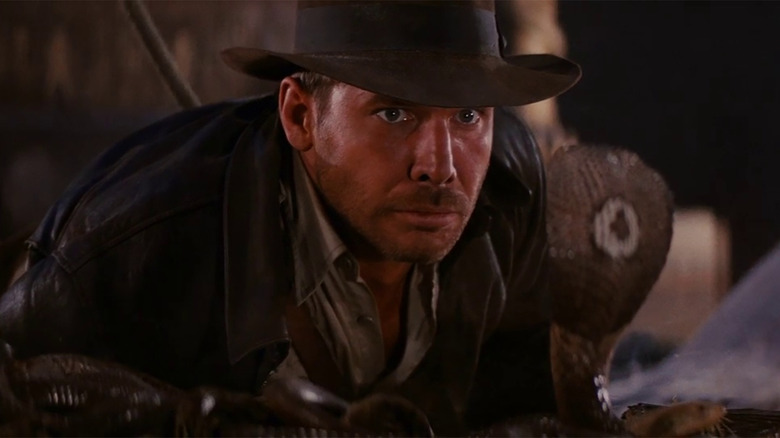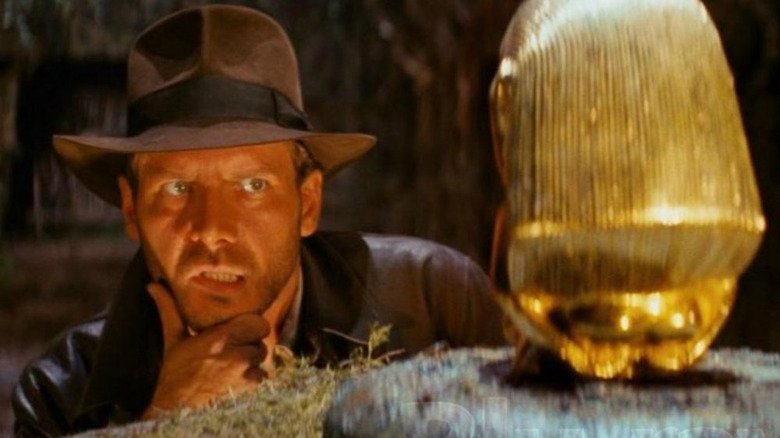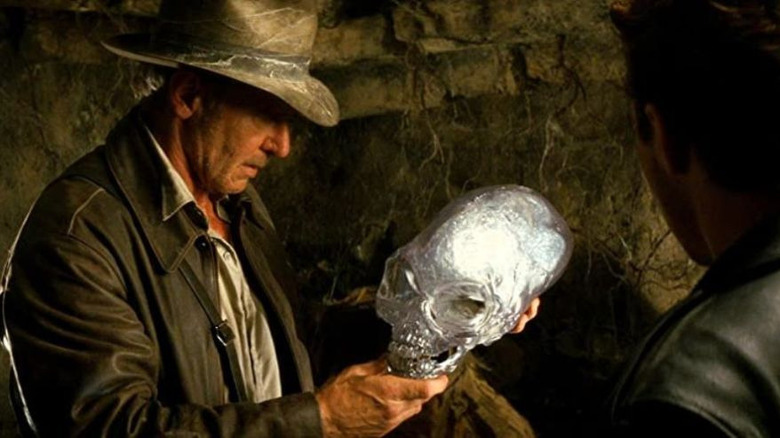George Lucas Thinks This Is The Key To Indiana Jones' Continued Success
After debuting on the big screen in 1981, the adventurer "Indiana Jones" has continued to stand the test of time. After four blockbuster films directed by Steven Spielberg and a fifth one on the way from "Logan" director James Mangold, one has to wonder: What is it about Harrison Ford's fedora-toting archaeologist that makes this iconic character so appealing?
"Indiana Jones" is a product of a wonderful collaboration between two iconic filmmakers: Steven Spielberg and George Lucas. After creating the character, George Lucas took Indy to Spielberg to direct, with screenwriter Lawrence Kasdan writing what would become "Raiders of the Lost Ark," and the rest is movie history. Dr. Henry Jones Jr. became a swashbuckler that audiences adored watching as he barely escaped the most daring adventures by the skin of his teeth. Back in 2008, George Lucas gave some insight into the continued success of the "Indiana Jones" franchise and what he believes is the reason behind the character's appeal.
Indiana Jones can take a beating
Speaking to Variety, Lucas explained the endearing and enduring nature of Indy and his action hero status that makes him stand out from the rest, especially when it comes to taking on bad guys:
"It's one of the few times when the hero gets beat up and he also looked like he got beat up, and he actually continues through the movie looking beat up. He didn't suddenly the next day come out, "Oh, yeah, my broken neck, my broken nose, that's all fixed now, nothing like a good night's sleep."
The believability of Indy's adventures also helps to make the films stand the test of time. It isn't just the way Indy takes hits, but also the treasures that are grounded in history in some form or another. Lucas said:
"We just had to make a good story and tell it well, and, yes, it's an action movie, but it's important for us that there's a real supernatural mystery going on. Only Indiana Jones films are supernatural mystery movies. They're always going after some supernatural object. It's not a pretend object. It's not something that we made up. It's something that actually exists, or people believe exists..."
Suspending disbelief
Lucas has the belief that "Indiana Jones" continues to succeed because audiences' suspension of disbelief isn't too tall of a task for an "Indiana Jones" adventure. He even went so far as to compare it to the massive success of "Jaws", saying that film's firm establishment with some sense of realism gets audiences invested:
"It was the same thing with Steven [Spielberg] with 'Jaws.' They said, 'Let's make it a 30-foot shark.' He said, 'There is no such thing as a 30-foot shark. They have caught a 21-foot shark. We'll make it a 24-foot shark.' That's where the difference is. We try to keep it within the realm of reality, but stretch it just a bit to make it more interesting and have more fun with it. And also, it's based on some kind of real mythology that exists that people actually believe in."
"Stretch it just a bit" is a great way to describe the first three "Indiana Jones" adventures in how they make Indy and his experiences believable. However, Lucas' belief in keeping things grounded isn't consistent with the fourth entry in the franchise, which is easily an example of what could go wrong when not applying what Lucas believes to be the key to success for the "Indiana Jones" franchise.
New decade, new Indy
While the believability of the first three films isn't in question, Lucasfilm teetered on the edge of unbelievable with the fourth installment, "Indiana Jones and the Kingdom of the Crystal Skull." The sequel differentiates itself from the rest of the series with its action and MacGuffin.
While Lucas speaks of grounding a story in something that people believe in, "Crystal Skull" features Indy taking physical feats that, while expected of action films in the decade it came out in, were hardly ever achieved by Indy in the original films, and that was when he was a much younger adventurer.
Add to that the sci-fi angle introducing aliens into the equation, and you have a film that stands far removed from Lucas' original principle. The fourth film saw Indy encounter aliens with psychic energy (and their crystal skull) and even had him survive a nuclear explosion by hiding in a fridge. Hell, it even resulted in coining the term "nuke the fridge" to describe over-the-top moments, along the same line as "jump the shark" from "Happy Days." The sequel came off a nearly 20-year gap between films, so it's not surprising that "Crystal Skull" takes a leap further from "The Last Crusade," but it's all a bit much.
Hopefully, James Mangold and the crew at Lucasfilm will continue the trend of the first three "Indiana Jones" films and engage audiences in the sense of grounded action and pseudo-history when the next film in the franchise comes out next summer on June 30, 2023.



